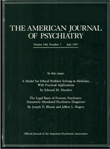30-Month Stability of Personality Disorder Diagnoses in Depressed Outpatients
Abstract
OBJECTIVE: This study examined the 30-month stability of axis II conditions. METHOD: One hundred eight depressed outpatients received comprehensive, semistructured personality disorder assessments at baseline and at follow-up. RESULTS: The diagnostic stability of personality disorders ranged from low to moderate at the categorical level and was generally moderate at the dimensional level. Most disorders exhibited good discriminant validity, in that the association between a disorder at baseline and at follow-up was greater than the associations between that disorder at baseline and the other 11 axis II disorders at follow-up. Two variables, sex and lifetime history of substance abuse or dependence, were significantly related to change in level of personality disorder features over time. CONCLUSIONS: Personality disorders have low to moderate stability over a 30-month period in depressed outpatients.



